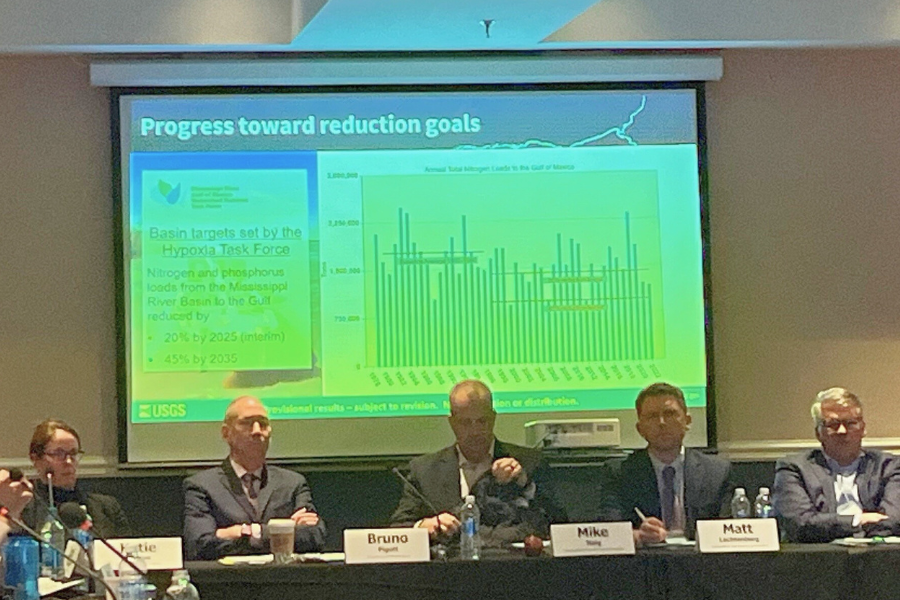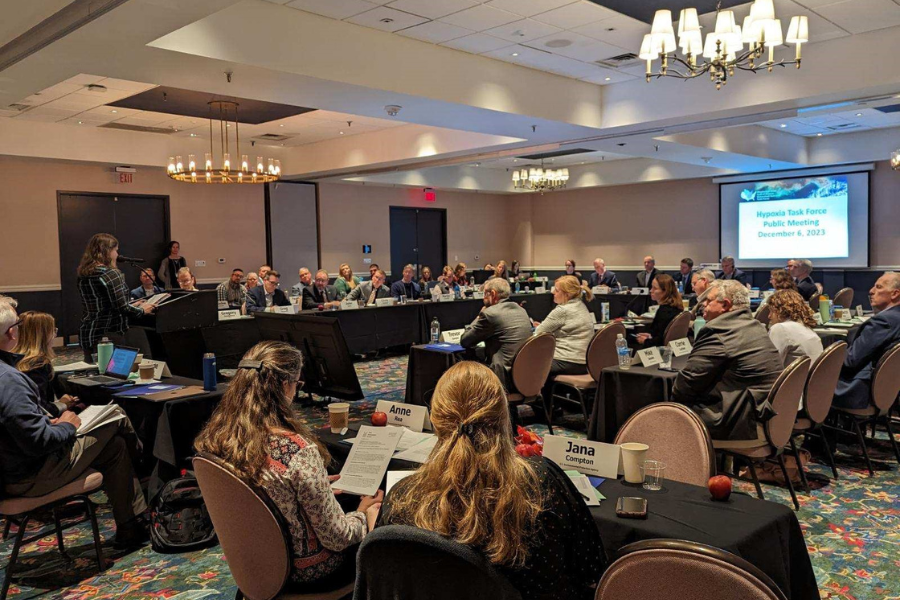The 2023 Gulf Hypoxia Task Force meeting: (No) impetus for change
posted
by Alicia Vasto on Friday, December 8, 2023
Last week, I attended the 38th public meeting of the Gulf Hypoxia Task Force (GHTF) in Fayetteville, Arkansas. Iowa is one of 12 states in the GHTF, established in 1997 to address the fertilizer pollution (nitrogen and phosphorus) that creates a Dead Zone in the Gulf of Mexico. If you’ve followed IEC or subscribed to Iowa Water Watch for a while, you’ll know that this same pollution affects our waters here at home, leading to harmful algae blooms and degraded drinking water that affects millions of Iowans.
For the last couple of years, I participated in the GHTF meetings virtually, making oral comments in 2021 and submitting written comments in 2022 when the meeting was held in Washington, D.C. This year, after pressure from environmental groups like IEC and our partners at the Mississippi River Network (MRN), the meeting was finally held in the Mississippi River basin. Because 2023 is the tenth anniversary of the publication of Iowa’s Nutrient Reduction Strategy (NRS), our state’s approach to addressing fertilizer pollution, I decided to drive to Arkansas to be sure my comments were heard and see what these meetings are really about.
The format is fairly standard: a closed, invite-only morning session for Task Force members, followed by an afternoon public session featuring presentations and public comment at the end. The public meeting was streamed virtually, but only those attending in person could make oral comments.
 Federal partners and five states gave presentations and updates during the public session; Iowa did not present.
Federal partners and five states gave presentations and updates during the public session; Iowa did not present.
The EPA shared a summary of the key messages of the GHTF’s 2023 Report to Congress. Takeaways from the report included how important monitoring and appropriate models are for evaluation of progress, which is something IEC has been calling for in Iowa for years, even as state leaders downplay the role of monitoring.
The EPA also included updated predictions of the impact climate change will have on the Gulf to help states adapt their Nutrient Reduction Strategies. This would be valuable information to incorporate should Iowa’s leaders ever decide to evaluate and update the NRS.
Other federal bureaus provided updates on:
- the size of this year's Dead Zone (the seventh smallest on record due to drought, but still two times larger than the goal);
- nitrogen and phosphorus loading trends (down, almost entirely due to the Mississippi River's low flow because of extreme drought in the basin);
- increased funding for Farm Bill conservation programs for best management practices (which are not being monitored “with any granularity” for water quality outcomes but almost all of which USDA says have water quality benefits).
The most notable thing I learned from the state updates, provided by Arkansas, Indiana, Kentucky, Louisiana, and Minnesota, was that the Task Force members were treated to a presentation by the Farm Bureau during the closed morning session. The agenda for the morning session is not publicly available, so this was news to me. It reminded me of how representatives from the Illinois Farm Bureau and Agricultural Nutrient Policy Council provided an update to the Task Force during the 2021 meeting. As far as I know, environmental groups have not been invited to present to the Task Force or given such access in the last few years. We are instead relegated to the public comment section of the meeting and given just 3-4 minutes to speak.
 The oral comments I provided were much more pointed than the written comments I submitted prior to the meeting. I prepared my oral comments before the meeting but made a few adjustments as I heard other presentations, including letting them know I would be happy to present at a future meeting.
The oral comments I provided were much more pointed than the written comments I submitted prior to the meeting. I prepared my oral comments before the meeting but made a few adjustments as I heard other presentations, including letting them know I would be happy to present at a future meeting.
My comments were much more critical than the tone of the rest of the meeting, which focused on successes coming from the states and federal agencies.
My main takeaway from this dichotomy is the same as in previous years and a conclusion that I’m sure many others have come to: this group is not serious about reducing fertilizer pollution and shrinking the size of the Dead Zone.
We know this because doing so would require transformative change in how agriculture operates and how we regulate fertilizer pollution. Those things are not on the table for the Task Force. Instead, the Task Force’s solutions and the "progress" updates they provide only circle around the edges of the problem, protecting the status quo of conventional agriculture and ignoring any serious undertaking required for significant progress.
As I’ve said before, Iowa’s approach is entirely lacking when it comes to addressing fertilizer pollution in our waterways. I believe the federal government’s approach is similarly lacking. In my conversations with other attendees in Fayetteville following the conclusion of the meeting, many acknowledge that the GHTF is nowhere close to accomplishing its goals and a real strategy to address Gulf hypoxia would require transformation of agriculture. But the political will to act is missing and powerful agriculture interests are working to ensure it can never surface.
Therefore, we are stuck working within this framework until the Dead Zone becomes so devastating that it can no longer be ignored, or the GHTF falls apart.
However, despite my experience and frustrated rhetoric, there is still reason for hope. While this meeting – and the many others that I attend related to the NRS and Iowa’s water quality – leave me with a feeling of powerlessness and anger, I’ve come to view this problem in the same way that I view climate change. While we can’t stop the pollution and negative outcomes from occurring entirely, we can take action to prevent the worst case scenarios.
Some of the solutions are so reasonable and common-sense that even the EPA could get to the point of implementing them if the public exerts enough pressure. These solutions wouldn’t require additional taxpayer funding (or could at least use taxpayer funding already available) to make significant reductions in fertilizer pollution:
- Regulate fertilizer and manure application to farm fields – only allow application at rates appropriate for plant uptake, ban fall application, and enforce penalties for overapplication.
- Require stricter regulation of concentrated animal feeding operations (CAFOs) as point sources of pollution.
- Support diversification in agriculture by prioritizing support for crops other than corn and soybeans, "alternative" cropping systems, and the return of livestock to the landscape.
- Remove bureaucratic barriers for farmers and agencies to install conservation practices.
- Embark on a coordinated, whole-basin approach to reducing the Dead Zone by writing a Total Maximum Daily Load (TMDL) for nitrogen and phosphorus for the Mississippi River. Write an updated whole-basin action plan based on the TMDL and load allocations for each state. Enforce penalties for failure to comply with the TMDL.
- Standardize reporting requirements for state Nutrient Reduction Strategies including benchmarks, timelines, and regular updates based on evaluation, especially in light of climate change.
- Using Bipartisan Infrastructure Law dollars for the GHTF, place dedicated staff in each state to coordinate and communicate between and among state and federal agencies. Dedicated staff could leverage federal resources to provide additional tools and capacity, coordinate pollution reduction efforts and monitoring, and increase efficiency and frequency of reporting.
- Implement numeric nutrient criteria.
 So I’m not giving up, and neither should you. We must continue to call for real solutions and accountability for clean water in Iowa, the Mississippi River, and Gulf of Mexico. We can still improve and protect water quality for Iowans, our downstream neighbors, and the fish and wildlife that call these places home.
So I’m not giving up, and neither should you. We must continue to call for real solutions and accountability for clean water in Iowa, the Mississippi River, and Gulf of Mexico. We can still improve and protect water quality for Iowans, our downstream neighbors, and the fish and wildlife that call these places home.
If you’d like to take action, please email Radhika Fox and Bruno Pigott at the U.S. EPA.
- cafos
- clean water
- climate change
- harmful algal blooms
- nitrate pollution
- nutrient reduction strategy
- phosphorus pollution
- toxic algae
- water quality